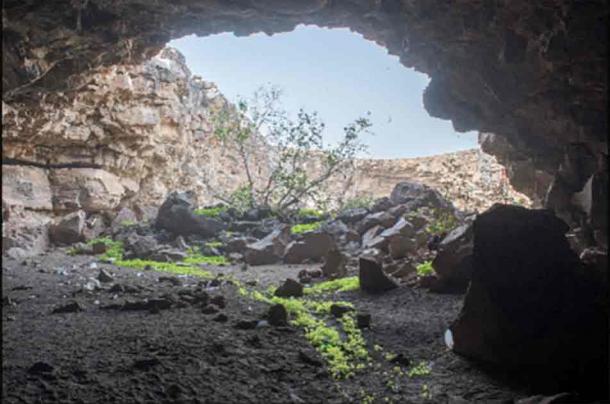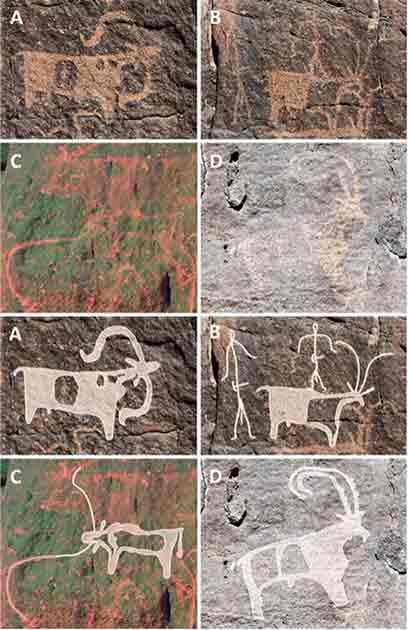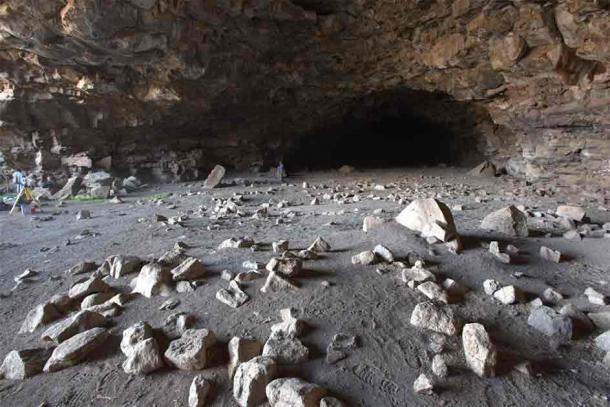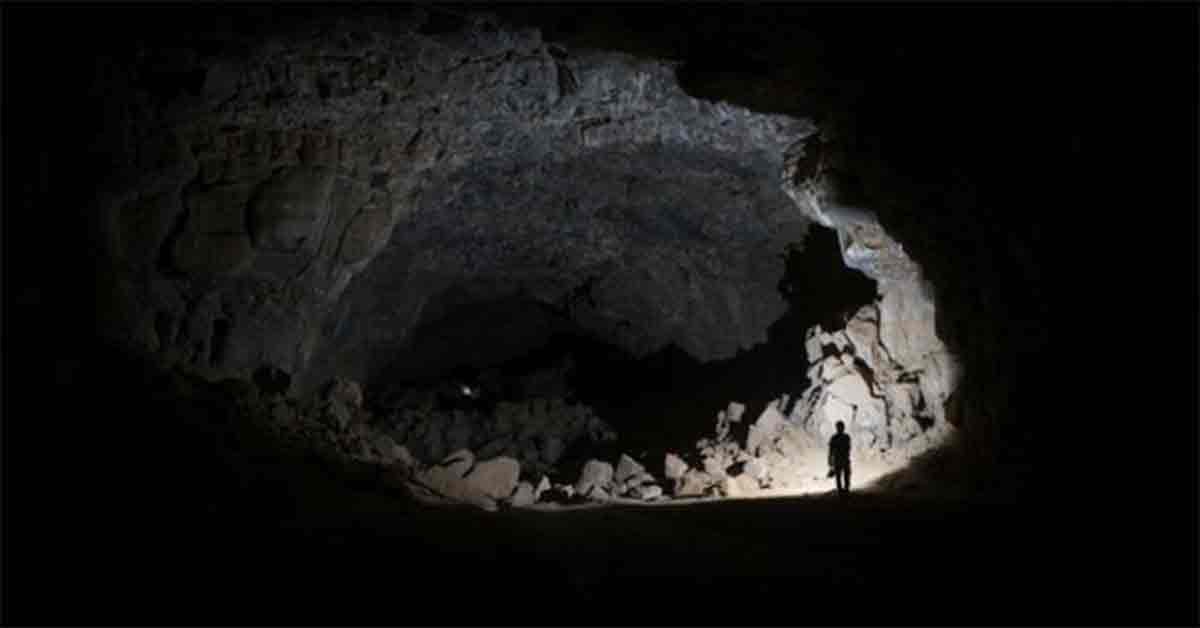Giant Lava Tunnel Was Occupied By Ancient Herders in the Arabian Peninsula
A fabulous new study has highlighted the lifestyles of human herders spanning 10,000 - 7,000 years ago, from the Neolithic to the Chalcolithic/Bronze Age, in the challenging desert environment of the Arabian Peninsula. A mountain of evidence has emerged from a cave occupied by prehistoric humans formed by flowing lava, called Umm Jirsan, including rock art and animal bones, that have helped the researchers delve into the use of the lava tunnel network and the diet of these prehistoric humans.
The understanding of this way of life has long been hindered by the limited preservation of organic materials in the arid conditions of the region, until this new study published in PLoS One.
- The Cult, Pilgrimage – and Herding Past of a Saudi Arabian Mustatil
- 30,000 Year 'Arabian Standstill': New Phase in Human Migration Detected

Looking out of entrance to Umm Jirsan. (Trench 1 just out of view on right). (Stewart et al. /PLoS ONE)
Examining Umm Jirsan: Impermanent Occupation
Located approximately 125 kilometers (77.6 miles) north of the city of Madinah, within the Harrat Khaybar lava field, lies the Umm Jirsan lava tube. Formed through the gradual cooling of lava over time, this remarkable geological feature stretches an impressive 1.5 kilometers (0.93 miles) in length. Some sections of the tube soar to heights of 12 meters (39.3 feet) and span widths of up to 45 meters (147.6 feet)!
Upon entering the dark and winding tunnels of the lava tube, the archaeologists reported being struck by a floor carpeted with piles of bones, housing thousands — if not hundreds of thousands — of exquisitely preserved fossils. The presence of art and animal bones within this lava tube offer an insight into the pastoral lifestyle of ancient peoples, who herded sheep and goats in the region.
- Study Dispels Human Meat Diet Hypothesis, Changing Evolutionary Story
- Ritual Platform Discovered in Saudi Arabia, With Egyptian Artifacts

Rock art found near Umm Jirsan shows animals and people. (Stewart et al. 2024 / PLoS ONE)
However, the scarcity of stone tool fragments, or lithic artifacts, suggests that human occupation of the tunnels was relatively fleeting. In fact, the low density of lithic is a clear indicator that human occupation was certainly neither intensive, nor extensive.
"Our findings at Umm Jirsan provide a rare glimpse into the lives of ancient peoples in Arabia, revealing repeated phases of human occupation and shedding light on the pastoralist activities that once thrived in this landscape," said Dr Mathew Stewart, the lead researcher and a Research Fellow at ARCHE, quoted in a press release. "This site likely served as a crucial waypoint along pastoral routes, linking key oases and facilitating cultural exchange and trade."
Understanding Dietary Changes: The Birth of Oasis Agriculture
At the same time, chemical signatures matching C3 plants were discovered in the human remains examined by the archaeologists, indicating traces of fruits and cereals in their diets. These diets were high in protein, as the carbon and nitrogen analysis point to.
The findings suggests a gradual increase in the consumption of such resources over time, coinciding with the emergence of agriculture in Arabia during the Bronze Age, predominantly in the form of oasis agriculture.
In fact, the transition in diet culminating in oasis agriculture brought about sophisticated farming and water management methods, allowing for more permanent settlement in the desert areas and the cultivation of crops like dates and figs.
"The lava tube does not appear to have served as a permanent habitation location, but rather as a site that likely lay on herding routes and that allowed access to shade and water for passing herders and their animals," the authors wrote in the study. "Prior to this, as well as during pastoral periods, the lava tube was likely also linked with hunting activities, which probably remained a cornerstone of local economies into the Bronze Age."

At the mouth of the eastern passage of Umm Jirsan. (Green Arabia Project)
Lava Tunnel on Important Route
A second astounding observation also emerged when the archaeologists returned from the excavation. While examining maps of archaeological structures in the broader vicinity, they observed that Umm Jirsan lies along a significant "funerary avenue" linking two major oases. These avenues, characterized by chains of tombs extending hundreds of kilometers, are thought to have served as pathways utilized by Bronze Age pastoralists for the movement of their herds between various water sources, they explain in an article authored for The Conversation.
Recent years have seen archaeologists uncover remarkable discoveries in Arabia, including findings in settings like ancient lakebeds. The discoveries at Umm Jirsan contribute another crucial element to the narrative of Arabian societies across different periods, shedding light on their interactions with the landscape and resources of a region.
Top image: Deep within the Umm Jirsan lava cave system, archeologists find signs of transient desert life. Source: Green Arabia Project
By Sahir Pandey
References
Andrews, R.G. 2024. This Lava Tube in Saudi Arabia Has Been a Human Refuge for 7,000 Years. Available at: https://www.nytimes.com/2024/04/17/science/saudi-arabia-lava-tube.html.
Jarus, O. 2024. Humans were living in a lava tube 7,000 years ago on the Arabian Peninsula. Available at: https://www.livescience.com/archaeology/humans-were-living-in-a-lava-tube-7000-years-ago-on-the-arabian-peninsula.
Rosengreen. C. 2024. ‘First evidence of human occupation in lava tube cave in Saudi Arabia’. Griffith University. Available at: https://news.griffith.edu.au/2024/04/18/first-evidence-of-human-occupation-in-lava-tube-cave-in-saudi-arabia/
Smaglik, P. 2024. Underground Lava Tubes Were Desert Pit Stops for Humans 7,000 Years Ago. Available at: https://www.discovermagazine.com/the-sciences/underground-lava-tubes-were-desert-pit-stops-for-humans-7-000-years-ago.
Stewart, M. et al. 2024. First evidence for human occupation of a lava tube in Arabia: The archaeology of Umm Jirsan Cave and its surroundings, northern Saudi Arabia. Available at: https://doi.org/10.1371/journal.pone.0299292.

















